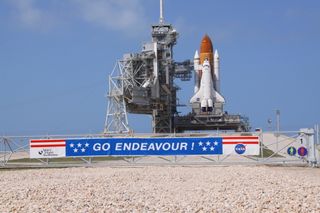NASA Tests Space Shuttle Repairs for Endeavour's Last Launch

NASA is testing repairs on the space shuttle Endeavour in the hopes they will allow the orbiter to launch on one final mission next week.
Shuttle officials called off Endeavour's first launch attempt on Friday (April 29) when two heaters protecting a crucial power unit had failed. Without the heaters, the unit would likely freeze on orbit and be unable to serve its role as one of three power sources for Endeavour's hydraulic systems during re-entry and landing.
Workers at NASA's Kennedy Space Center in Cape Canaveral, Fla., spent last weekend inspecting the problem, and traced it back to a broken control box that sends power to the heaters. They've since removed the old box,called a Load Control Assembly-2 (LCA-2), and replaced it with new one on Wednesday (May 4). [Photos: Shuttle Endeavour's Final Voyage]
They are now testing the old box to determine the source of the problem.
"Technicians are trying to determine what caused the power box to fail," according to a NASA statement. "Initial testing from yesterday shows a driver (circuit) inside the LCA-2 shorted out."
NASA has not set a new launch date for Endeavour, but mission managers have said the mission will not lift off before May 10. A meeting of top shuttle manager tomorrow (May 6) is expected to end with a new launch target.
"Managers will continue to evaluate the repair process and make any additional adjustments before scheduling Endeavour’s next launch attempt, which remains no earlier than May 10," NASA's statement said.
Get the Space.com Newsletter
Breaking space news, the latest updates on rocket launches, skywatching events and more!
Endeavour is slated to carry six astronauts, an astrophysics experiment, and a shipment of spare parts to the International Space Station. The STS-134 mission is scheduled to last 14 days, but NASA hopes to add two extra days in orbit to allow the astronauts to complete more work. [Gallery: Space Shuttle Endeavour Construction Photos]
Endeavour's crewmembers returned to Houston, where they live and train, after their launch delay. The crew will continue training until a new launch date has been set. Wednesday the astronauts met with their flight directors and robotics and spacewalk officers to review plans for their mission.
After Endeavour's flight, NASA has only one more space shuttle mission planned. The shuttle Atlantis is scheduled to lift off June 29 for its last journey to the International Space Station. However, if Endeavour's mission is delayed much further, NASA has said the Atlantis flight could be pushed back, too.
Once the orbiters are retired, they will be sent to museums for public display.
Endeavour is bound for the California Science Center in Los Angeles, while Atlantis will go to the Kennedy Space Center's Visitor's Center. Their sister orbiter, Discovery, is marked for the Smithsonian's Air and Space Museum in Washington, D.C. A prototype shuttle called Enterprise, which never made it to space, will be displayed at New York's Intrepid Museum of Sea, Air and Space.
You can follow SPACE.com Senior Writer Clara Moskowitz on Twitter @ClaraMoskowitz. Follow SPACE.com for the latest in space science and exploration news on Twitter @Spacedotcom and on Facebook.
Join our Space Forums to keep talking space on the latest missions, night sky and more! And if you have a news tip, correction or comment, let us know at: community@space.com.

Clara Moskowitz is a science and space writer who joined the Space.com team in 2008 and served as Assistant Managing Editor from 2011 to 2013. Clara has a bachelor's degree in astronomy and physics from Wesleyan University, and a graduate certificate in science writing from the University of California, Santa Cruz. She covers everything from astronomy to human spaceflight and once aced a NASTAR suborbital spaceflight training program for space missions. Clara is currently Associate Editor of Scientific American. To see her latest project is, follow Clara on Twitter.
